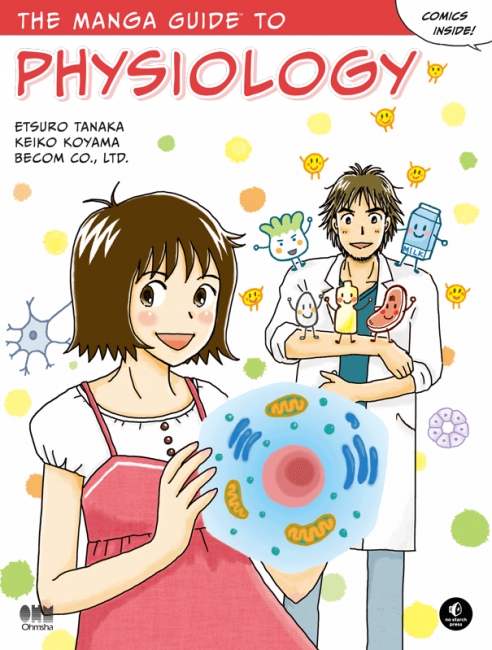To most students, physiology is a difficult and mind boggling subject. Thankfully, Dr. Tanaka and Dr. Koyama have poured their love and patience into an illustrated work of organ-based physiology, The Manga Guide to Physiology.
Presented in the Japanese graphic novel style of manga, the manga follows nursing student protagonist Kumiko as she prepares for her make-up examination in physiology. Manga’s vast plethora of genres enables such series to cater to a wide range of audiences regardless of background and age. Its characteristic dramatic expressions and brief interludes of comic relief provide an entertaining way to incorporate learning with leisure. In this way, The Manga Guide to Physiology serves as an excellent resource for a casual review or introduction to essential topics in physiology.
However, for the modern medical student, this author suggests the utilization of this book more heavily as a source of light entertainment and amusement rather than substantial supplementary material. This review will discuss the strengths and possible utilities this manga may have for selective audiences as well as elaborate on potential downfalls to bear in mind as a medical student reader. Overall, it is this author’s opinion that this manga is most useful and educational for the budding student of science at the high school or collegiate level.
Through each chapter, nursing student Kumiko engages with Professor Kaisei in spontaneous, circumstantial teaching lessons as they incidentally bump into each other on campus that are followed by a more comprehensive lecture-style conversation with text and diagram explanations at the conclusion of each chapter. This balanced interchange between illustrations and text allow for a smooth read without inundating the reader with exhaustive bulky material. To make concepts more memorable, the cutely drawn caricatures provide impressionable ways of integrating information (i.e. the team of gastric secretions to break down proteins on page 60, the red appearance of oxygenated hemoglobin due to hemoglobin’s embarrassment of oxygen’s “affectionate” bonding with it on page 113). Likewise, Drs. Tanaka and Koyama utilize humorous illustrated metaphors to explain complex concepts such as the pulmonary-circulatory gas exchange system. Additionally, well-placed informational tidbits about Japanese culture — especially their various local eateries and idioms — break up the torrent of information to allow the audience a quick breather before diving back into learning. Although significant coverage of information spanned the 226 pages of the book, the thoughtful design and manga-styled approach made for an enjoyable and stress-free experience; intelligent use of cultural trivia, entertaining metaphors and useful illustrations make for an accessible resource for reference in the future.
While numerous sugoi (“amazing” in Japanese) qualities comprise The Manga Guide to Physiology, the fundamental problem of informational depth and organization in all physiology texts is an important point to consider when utilizing The Manga Guide as an educational resource. In the foreword, it is unclear to which type of audience this book is specifically catered. Although the manga’s protagonist is a nursing student, it is the humble opinion of this writer that the information presented lacks the depth necessary for graduate students in the health fields. While all students of medicine and physiology may benefit from this work, clarifying the targeted level of understanding is important for the reader to appropriately adjust his or her perspective towards its function. The majority of the content focuses on normal physiology and does not spend many pages on pathophysiology or crucial clinical presentations. The paucity of anatomy coverage, in depth exploration of physiological mechanisms, and its correlation to relevant pathophysiology for disease understanding place this book in the audience category of pre-graduate medical professional level. Consequently, this may be a resource more suitable for high school or undergraduate students for supplementation and reinforcement.
For the current medical student to obtain optimal utility from The Manga Guide to Physiology, several additional steps may be implemented to better supplement our curriculum. First, due to the simultaneous presentation of abundant information, it would be beneficial for the medical student interested in returning to this material to annotate the text with more organization, whether it is to visually mark (i.e. bold, underline, highlight, or box) relevant pieces or tag useful diagrams or text for future reference. This way, students can incorporate this text into more of a reference material rather than a single read-through. Second, since many of the sections of each organ-based chapter are missing essential physiological concepts or clinical pathophysiological correlations, it is crucial to have other materials at hand to provide more complete and detailed information. Supplementary textbooks or online resources, for example, would further supply explanations of the mechanisms of normal physiology, anatomy, and interactions among the different organ systems — concepts necessary for a comprehensive medical education curriculum.
Ultimately, No Starch Press has collaborated with the professors at Tokyo University to create a wonderfully crafted, entertaining, and enriching learning experience for the student of physiology. Although the material may not be sufficient to serve as a primary resource of educational information for medical students, it serves as a stress-free and creative supplementation to learning physiology.

